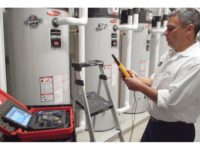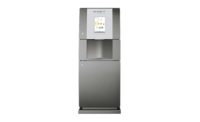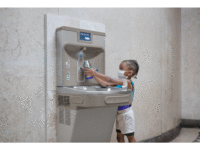COVID-19 has certainly changed the way people live and interact with their environment. Face masks have become the norm, along with carrying around your own personal hand sanitizer or disposable gloves. This heightened awareness around hygiene has also impacted drinking water fountains and bottle filling stations.
Drinking water fountains serve an important function, providing free access to safe municipal water — offering an alternative to bottled water or sugary drinks — and accommodate a wide array of users, including children, college students, commuters, runners, tourists and pets to name a few. According to the Centers for Disease Control and Prevention (CDC), it is possible for people to get COVID-19 by touching a surface or object that has the virus on it, then touching their own mouth, nose or eyes, though this is not the main way the virus spreads. However, many people are not willing to take the risk.
The touchless trend
“As the pandemic continues, we can expect to see more hygienic and health-focused products incorporated both inside and outside of the home,” notes Damon Shaw, director, product management — drinking water for Elkay. “Overall, consumers are more interested in health and wellness these days, and with that, want design elements that will support that lifestyle. Bottle filling stations are a great way to provide healthy hydration and as this product continues to become popular, we will see a larger focus on hands-free and touchless options.”
The pandemic has propelled the demand for more sanitary and hygienic features, such as hands-free products, in commercial, public and even residential spaces, Shaw explains.
“The need for more hygienic features will continue to rise as people make personal choices for health and wellness and commercial spaces transform to accommodate the public need for more sanitary facilities, incorporating products like Elkay’s ezH2O bottle filling stations that offer hands-free sensor activation to provide users with a touchless bottle filling experience, resulting in a cleaner and healthier environment,” Shaw says.
James Burwell, director of global product management, Haws Corp., notes there has been an increase in bottle filling station placements in recent years.
“This is because of the ecological benefits of reducing waste with single-use bottles and consumers moving toward reusable bottles,” he says.
“Additionally, COVID-19 has really ramped up the desire to install bottle fillers. With COVID-19, many outlets appreciate the hands-free activation option of bottle fillers, so they have moved to touchless options to reduce contact of common surfaces in addition to the environmental benefits of reducing single-use containers.”
Burwell adds the global pandemic has significantly impacted user interactions and expectations.
“The market wants options that allow users to decide how to interact and access water,” he says. “One consideration with COVID-19 is how to support water accessibility for all users. Not everyone has the ability to use one option, (i.e. touchless bottle fillers only) so providing options for all users that are hygienic, convenient and accessible is critical.”
Looking ahead
The health and wellness trend will not slow down anytime soon, Shaw notes.
“That coupled with the fact that people are more eco-friendly and care about our planet is what will keep the demand for bottle filling stations on the rise,” he says. “The pandemic has also helped people become hyper-aware of health and wellness, and bottle filling stations are an innovative way to improve health and hygiene.”
Burwell expects the demand for combination bottle filling and drinking fountains to continue to increase significantly over the next several years.
“This is not only in response to COVID-19, but the increasing desire to eliminate waste and single-use water bottles,” he says. “It is important to note there have been no changes to the ADA requirements in section 211.2., which states ‘no fewer than two drinking fountains shall be provided. One drinking fountain shall comply with 602.1 through 602.6 [for wheelchair accessibility], and one drinking fountain shall comply with 602.7 [for standing persons with disabilities bending or stooping].’ We will continue to see the transition to more accessible options for all, and we are confident that ADA regulation and building codes will continue to support the development and implementation of ADA-compliant fountains.
“2020 has proven to be a pivotal point in the hydration space, and we will continue to see the effects in years to come,” Burwell adds. “Hydration manufacturers will have to continue to seek ways to innovate in the market to provide solutions that are hygienic, sustainable and accessible. Expectations of healthy, clean accessible water options will continue to evolve, and Haws will continue to provide solutions that suit a variety of environments and individual functionality needs.”
BOTTLE FILLING PRODUCTS
Elkay
Product name: ezH2O Liv.
Release date: May 2019.
Product description: Elkay takes water delivery to a new level with ezH2O Liv, a filtered water dispenser designed to seamlessly fit in any space, the company states. With two versions — one for the home and one for commercial spaces — it's a sleek, convenient addition to any room. The ezH2O Liv goes beyond water delivery, offering peace of mind with an NSF-certified filter that reduces lead and other harmful contaminants from water.
Website: elkay.com/ezH2O-Liv

Haws
Product name: Wall Mount Hi-Lo ADA Touchless Water Cooler and Bottle Filler.
Release date: The EWC 1200 Series, including the 1212SF was released in January 2020. The touchless model (1212SFH) was released in June 2020.
Product description: The stainless steel Hi-Lo wall-mount ADA touchless water cooler and bottle filler features sensor operation for hands-free hygienic activation, and bubbler deactivation feature. The modern, innovative design is tailored to meld with office spaces, universities, airports and spaces such as a school gymnasium. The Hi-Lo dual station design allows for standard left-side high/right-side low ADA fountain access. The sensor operated solenoid valves provide hands-free hygienic operation, and pressure-regulating bubblers with flexible antimicrobial rubber mouth guards requires no adjusting. The sensor activated bottle filler allows for hands free operation, and intuitive LED electronic displays how many plastic bottles have been saved.
Website: http://bit.ly/3bwAxJ9





